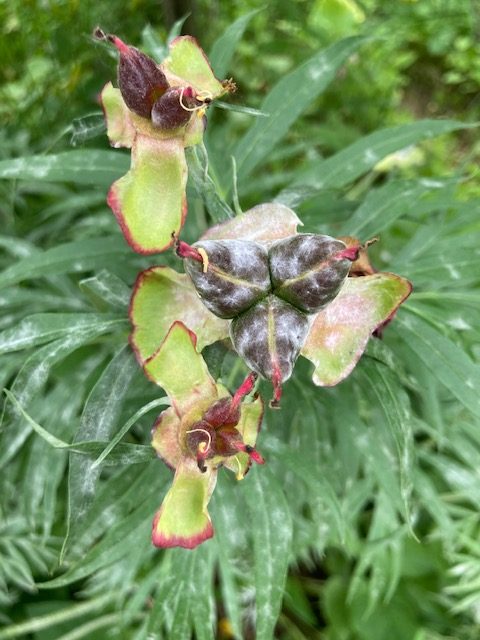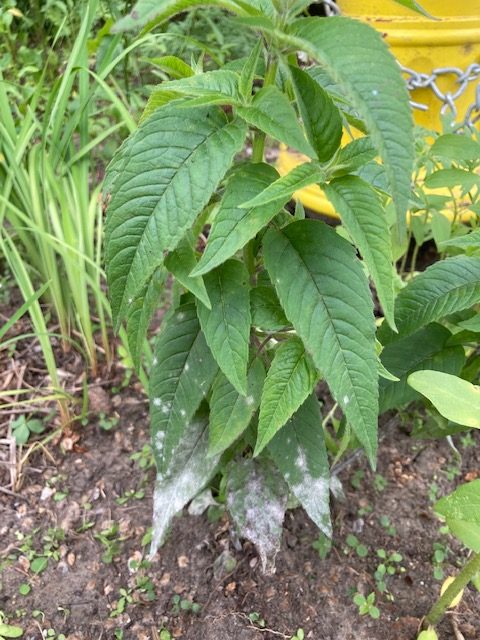
Powdery mildew infection of peony seed heads.
Jill Thomson
Saskatchewan Perennial Society
This growing season, there seem to be many plants affected by mildew early in the season, particularly in my shady front yard. The affected leaves are easily recognisable by the typical, white fungal growth, usually first noticed on the upper surface of infected leaves.
Powdery mildew is the common name for this fungal disease that attacks many different species of plants. Although the symptoms are usually very similar, there are very specific mildew fungi that cause disease on different hosts For example, mildew on grasses is caused by Blumeria (Erisyphe) graminis and on roses by Sphaerotheca (Podosphaera) pannosa. Lilacs are infected by Erisyphe syringae, whereas Sawadaea bicornis affects peonies. These mildew fungi have very similar life cycles: in the summer the fungus grows on living plant material and spreads from leaf to leaf, and from plant to plant by tiny airborne spores called conidia. These spores germinate on new plant surfaces and can penetrate the leaves, where they form specialized structures called haustoria. Haustoria have a central body with multiple finger-like projections that extract nutrients from the plant cell enabling the fungus to feed off the living plant.
Mildew is known as an obligate parasite because it must feed on living tissue. Mildew does not usually kill its host, but it will hasten the host’s decline. As the amount of infection increases, towards the end of the season, the fungus produces hard walled, black, pinhead-sized structures that can easily survive winter conditions. In the spring these structures produce a spore that initiates new infection, and once the infection is established, the summer spores are responsible for local spread of the disease.
In some plants, infected leaves can become misshapen: rose and high-bush cranberry leaves infected by mildew are curled and distorted as they expand. Peony flower heads seem to be more heavily infected after the petals begin to fall.
There are a number of ways to reduce mildew infection, and these apply to many types of garden plants – grasses, bushes, vegetables, annuals and perennials. Controlling the environment around your plants is a major tool to prevent or reduce mildew infection.
• Start by giving your plants space to allow good air circulation around and through the plants.
• Trim away bottom branches of lilac and rose bushes.
• Grow your plants in open, sunny areas, as long as these are also the right conditions for your plants.
• Although mildew spores do not need free water on the leaf surface in order to germinate and infect, they thrive in high humidity. To reduce infections, always water around the base of your plant in the morning, so the leaves can dry off quickly.
• Avoid using excessive nitrogen fertilizer as this encourages tender, new leafy growth, which is more easily infected than older, tougher growth.
• Remove infected material and clean up fallen leaves in the fall. This debris provides material for the overwintering stage of the fungus and will supply a new source of mildew infection in the spring.
• Mulching around bushes in the fall also keeps the spores from reaching leaves in the spring.
• There are some chemicals that can be purchased to help control mildew on favourite plants as well as many home-made recipes on gardening websites. Always treat a small area of the plant first, to see if it reacts adversely, allowing 24-48 hours to check for a response.
• When shopping for new plants, choose varieties that show resistance to mildew, if you are experiencing a persistent problem in your garden. There are roses that are less likely to develop mildew, however, they are not completely resistant.
These preventative measures also apply to the vegetable garden. Allow for good air circulation around your plants, in particular with cucumber, squash, pumpkins, muskmelon. These vine crops need to retain productive leaves to grow to maturity, so space them out to avoid early mildew infection. Young pea plants usually resist mildew infection; however, older plants almost always succumb to the disease, often after the main productive stage is over.
Mildew in your garden is something you cannot usually avoid, but keeping it to a manageable level is possible most years.
Jill Thomson is a plant disease specialist (retired) who enjoys gardening with her family in Saskatoon.
This column is provided courtesy of the Saskatchewan Perennial Society (SPS; saskperennial@hotmail.com ). Check our website (www.saskperennial.ca) or Facebook page (www.facebook.com/saskperennial) for a list of upcoming gardening events


